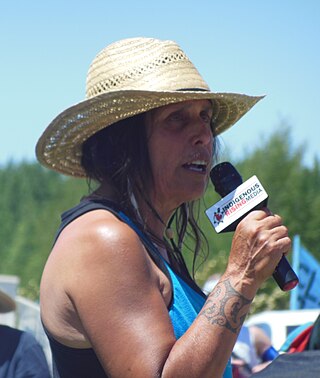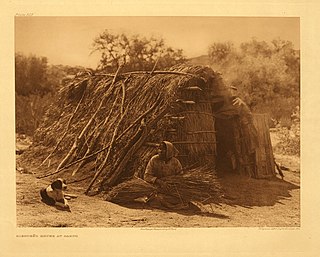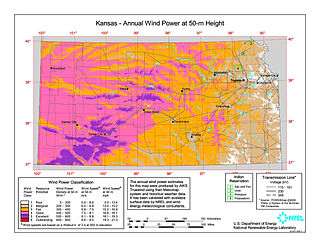Related Research Articles

The Lakota are a Native American people. Also known as the Teton Sioux, they are one of the three prominent subcultures of the Sioux people. Their current lands are in North and South Dakota. They speak Lakȟótiyapi—the Lakota language, the westernmost of three closely related languages that belong to the Siouan language family.

Winona LaDuke is an American economist, environmentalist, writer and industrial hemp grower, known for her work on tribal land claims and preservation, as well as sustainable development.

Byron Leslie Dorgan is an American author, businessman and former politician who served as a United States Representative (1981–1992) and United States Senator (1992–2011) from North Dakota. He is a member of the Democratic Party.

Tex G. Hall, is a Native American who was tribal chairman of Three Affiliated Tribes from 1998 to 2006. He lost the 2006 election to Marcus Levings, but in the 2010 tribal election, Hall defeated Levings. He ran for the position of President of the National Congress of American Indians in 2001 and won his campaign at the annual convention in Spokane, Washington over Chairman Brian Wallance of the Washoe Tribe of Nevada. Tex was reelected in 2003 at the annual convention in Albuquerque, New Mexico over Ernie Stensgar, Chairman of the Coeur d'Alene Tribe of Idaho.

The Pine Ridge Indian Reservation, also called Pine Ridge Agency, is an Oglala Lakota Indian reservation located almost entirely within the U.S. state of South Dakota, with a small portion in Nebraska. Originally included within the territory of the Great Sioux Reservation, Pine Ridge was created by the Act of March 2, 1889, 25 Stat. 888. in the southwest corner of South Dakota on the Nebraska border. Today it consists of 3,468.85 sq mi (8,984 km2) of land area and is one of the largest reservations in the United States.

Prairie Island Indian Community is a Mdewakanton Sioux Indian reservation in Goodhue County, Minnesota, along the Mississippi River. Most of the reservation now lies within the city of Red Wing, which developed after this land was set aside.
The Shoshone or Shoshoni are a Native American tribe with four large cultural/linguistic divisions:

An Indian reservation is an area of land held and governed by a U.S. federal government-recognized Native American tribal nation whose government is semi-sovereign subject to regulations passed by the United States Congress administered by the United States Bureau of Indian Affairs and not to the U.S. state government in which it is located. Some of the country's 574 federally recognized tribes govern more than one of the 326 Indian reservations in the United States, while some share reservations, and others have no reservation at all. Historical piecemeal land allocations under the Dawes Act facilitated sales to non–Native Americans, resulting in some reservations becoming severely fragmented, with pieces of tribal and privately held land being treated as separate enclaves. This jumble of private and public real estate creates significant administrative, political and legal difficulties.

The Oahe Dam is a large earthen dam on the Missouri River, just north of Pierre, South Dakota, United States. The dam creates Lake Oahe, the fourth-largest man-made reservoir in the United States. The reservoir stretches 231 miles (372 km) up the course of the Missouri to Bismarck, North Dakota. The dam's power plant provides electricity for much of the north-central United States. It is named for the Oahe Indian Mission established among the Lakota Sioux in 1874.

Lake Oahe is a large reservoir behind Oahe Dam on the Missouri River; it begins in central South Dakota and continues north into North Dakota in the United States. The lake has an area of 370,000 acres (1,500 km2) and a maximum depth of 205 ft (62 m). By volume, it is the fourth-largest reservoir in the US. Lake Oahe has a length of approximately 231 mi (372 km) and has a shoreline of 2,250 mi (3,620 km). 51 recreation areas are located along Lake Oahe, and 1.5 million people visit the reservoir every year. The lake is named for the 1874 Oahe Indian Mission.

The Standing Rock Reservation lies across the border between North and South Dakota in the United States, and is inhabited by ethnic "Hunkpapa and Sihasapa bands of Lakota Oyate and the Ihunktuwona and Pabaksa bands of the Dakota Oyate," as well as the Hunkpatina Dakota. The Ihanktonwana Dakota are the Upper Yanktonai, part of the collective of Wiciyena. The sixth-largest Native American reservation in land area in the US, Standing Rock includes all of Sioux County, North Dakota, and all of Corson County, South Dakota, plus slivers of northern Dewey and Ziebach counties in South Dakota, along their northern county lines at Highway 20.

The Crow Creek Indian Reservation, home to Crow Creek Sioux Tribe is located in parts of Buffalo, Hughes, and Hyde counties on the east bank of the Missouri River in central South Dakota in the United States. It has a land area of 421.658 square miles (1,092.09 km2) and a 2000 census population of 2,225 persons. The major town and capital of the federally recognized Crow Creek Sioux Tribe is Fort Thompson.

The Rosebud Indian Reservation is an Indian reservation in South Dakota, United States. It is the home of the federally recognized Rosebud Sioux Tribe, who are Sicangu, a band of Lakota people. The Lakota name Sicangu Oyate translates as the "Burnt Thigh Nation," also known by the French term, the Brulé Sioux.
The Intertribal Council on Utility Policy, or Intertribal COUP, is a Native American nonprofit organization founded in 1994. It focuses on energy, telecommunications, and environmental issues affecting member tribes in North Dakota, South Dakota, Nebraska and Wyoming.

The Campo Indian Reservation is home to the Campo Band of Diegueño Mission Indians, also known as the Campo Kumeyaay Nation, a federally recognized tribe of Kumeyaay people in the southern Laguna Mountains, in eastern San Diego County, California. The reservation was founded in 1893 and is 16,512 acres (66.82 km2).

At the end of 2016, the installed capacity for wind power in Minnesota was 3,500 megawatts (MW). Wind power generated nearly 18 percent of Minnesota’s electricity in 2016, ranking sixth in the nation for wind energy as a share of total electricity generation.

In the U.S. State of Kansas, wind power is the largest source of electricity, generating over 41% of the state's electricity in 2019. Kansas has a high potential capacity for wind power, second behind Texas. The most recent estimates (2012) are that Kansas has a potential for 952 GW of wind power capacity yet had only about 5.6 GW installed by year end 2018. Kansas could generate 3,102 TW·h of electricity each year, which represents over 75% of all the electricity generated in the United States in 2011. This electricity could be worth $290 billion per year.
Thomas Norton Tureen is an American lawyer and entrepreneur known for his work with American Indian tribes. While an attorney with the Native American Rights Fund he pioneered the use of the Nonintercourse Act to obtain return of tribal lands lost 180 years earlier and federal recognition for previously non-federally recognized tribes. Tureen successfully litigated Joint Tribal Council of the Passamaquoddy Tribe v. Morton (1975), which established that the federal government has a trust responsibility to protect the land of all tribes, including those not previously recognized. Between 1972 and 1983 he helped obtain federal recognition for and the return of over 300,000 acres to five New England tribes. Tureen's work on behalf of the tiny Mashantucket Pequot Tribe in Connecticut led to the creation of the Foxwoods Resort Casino, one of the largest casinos in the world. He arranged the acquisition of Dragon Cement, New England's only cement producer, by the Passamaquoddy Tribe ; the acquisition of Phoenix Cement by the Salt River Pima Maricopa Indian Community ; originated 250 MW Moapa Solar, the first utility scale solar project in Indian Country and had lead responsibility for the creation of a partnership controlled by the Morongo Band of Mission Indians that holds an option to acquire a $400 million interest in an electric transmission upgrade in Southern California.

Wind Powering America (WPA) is an initiative of the United States Department of Energy (DOE) that seeks to increase the use of wind energy throughout the United States. WPA collaborates with key state and regional stakeholders, including farmers, ranchers, Native Americans, rural electric cooperatives, consumer-owned utilities, and schools to break down barriers associated with wind energy development.
Solar power in North Dakota has been a little-used resource. The state ranks last on installed solar power in the United States, with .47 MW of installed capacity. Solar on rooftops can provide 24.6% of all electricity used in North Dakota from 3,300 MW of solar panels. The most cost effective application for solar panels is for pumping water at remote wells where solar panels can be installed for $800 vs. running power lines for $15,000/mile.
References
- ↑ Nigel Saunders (2007). Wind Power. Gareth Stevens. p. 23. ISBN 9780836884050.
- ↑ "Native Wind Releases Wind Energy PSA" (PDF). NAWIG News. National Renewable Energy Laboratory. p. 3.
- ↑ Chris Clarke (2 May 2017). "What's Keeping Tribes From Harnessing Their Wind Energy?". KCET . Retrieved 20 April 2022.